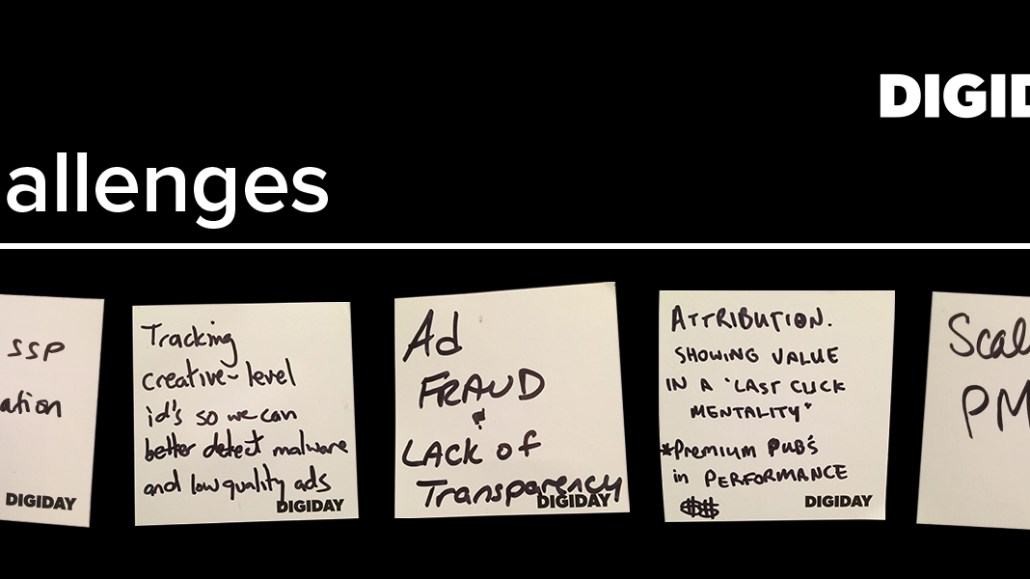Publishers’ programmatic woes: ‘We get punished by being premium’

Programmatic opens a revenue stream for publishers. But at the same time, publishers are paying exchanges or supply-side platforms hefty tech fees and dealing with issues like transparency and ad fraud.
In two town-hall style meetings (where discussions are not for attribution) at the Digiday Programmatic Media Summit in New Orleans this week, publishing attendees jotted down their biggest challenges. Among their chief complaints: Programmatic fees are too high, supply-side vendors aren’t incentivized to improve transparency, and Google’s customer service is lacking.
High programmatic fees

“We have around $15 CPM, and we get punished by being a premium publisher. Because of our high CPMs, we pay really high tech fees.”
Vendors stand in the way of transparency

“Ads.txt shows how much reselling takes place, which is a ridiculous amount. Many vendors asked us to add them to the ads.txt list. Some tech platforms that we have direct relationships with asked us to add resellers that they are working with, even though we don’t know those resellers.”
“It would be great if we can have a universal creative identifier, so we can see where a creative shows up and block ads that we don’t want to serve. Right now, most SSPs are not able to do that, saying that they are just middlemen.”
Google’s customer service is lacking

“Customer service is not a value-add for companies like Google. Sometimes you can get a really good Google rep, but then that person gets promoted and the next person we talk to knows nothing.”
“We are a midsize publisher. At first, we got terrible replies back from our Google rep. Then, we figured that they have qualitative and quantitative goals. If you can’t help them achieve their goals, they won’t jump in. Once we realized that they have goals, we started the conversation with asking their goals (typically one goal is to generate more overall revenue from their accounts), what the gap is and how we can help. Once we do that, the quality of [Google’s customer] service skyrockets.”
Scaling PMPs is hard

“Among the advertisers that have PMPs with us, approximately only 10 percent of them know how to leverage the data from those deals. Even if advertisers want to scale on always-on PMP deals, they don’t know how to do that. Meanwhile, advertisers’ KPIs are pretty static. What they wanted to achieve in 2015 is still something that they want to achieve in 2018.”
“Lots of things come down to the pricing and manpower on the buy side. Media buyers don’t have the capability to execute PMP deals across 15 premium publishers. You need to pick your battles, choosing advertisers whose campaigns can really do well on your inventory.”
Ad fraud is still rampant

“Ad fraud is tough, especially when it comes to video. Where does the ads.txt file sit when your inventory is livestreaming? In terms of display, things are represented in different ways, and ads.txt would be of huge help for that case. But it’s up to if buyers actually stop purchasing [inventory] from unauthorized sellers.”
“Many agencies are not transparent with clients. Agencies are able to buy cheap [inventory] from somewhere and sell for more, so we tried to talk to clients directly without throwing the agency in the dipping.”
Media buyers have a last-click mindset

“Ad buyers should know already that last-click attribution sucks. But I still feel like I’m educating them on basic stuff when I tell them why last-click doesn’t fully capture the value of your inventory.”
Zoom in below to see more publishers’ challenges.

More in Media

Publishers are hunting for AI prompt data — now they’re starting to get it from third-party companies
Publishers are finally gaining some visibility into AI search, as new prompt data tools crack open a black box.

Digiday+ Research: Publishers’ growing focus on video doesn’t translate to social platforms
Major publishers have made recent investments in vertical video, but that shift is not carrying over to social media platforms.

Technology x humanity: A conversation with Dayforce’s Amy Capellanti-Wolf
Capellanti-Wolf shared insight on everything from navigating AI adoption and combating burnout to rethinking talent strategies.








